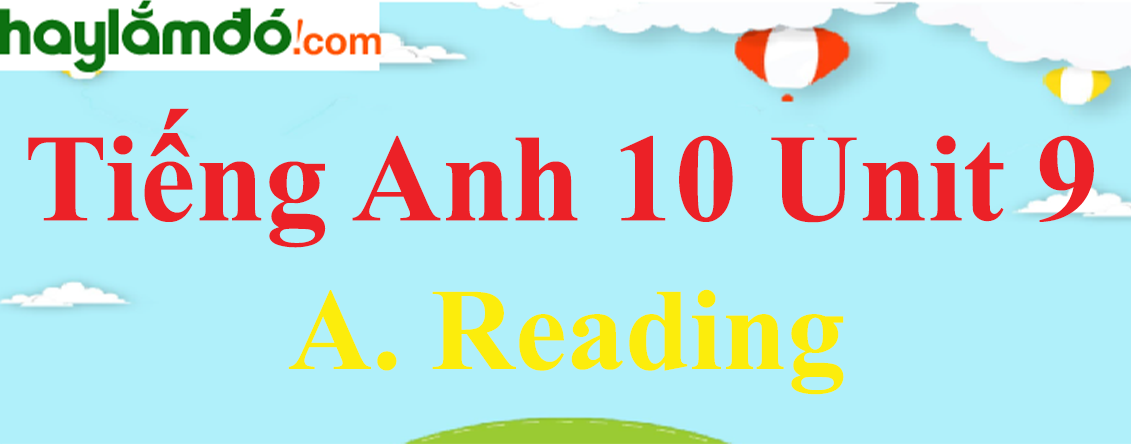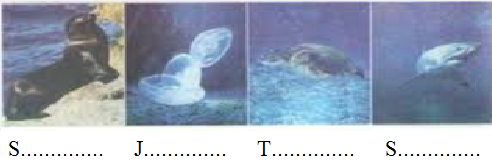Tiếng Anh lớp 10 Unit 9 A. Reading trang 94-95-96
Tiếng Anh lớp 10 Unit 9 A. Reading trang 94-95-96
Loạt bài soạn, giải bài tập Tiếng Anh lớp 10 Unit 9 A. Reading sẽ giúp Giáo viên, phụ huynh có thêm tài liệu để hướng dẫn các em học sinh lớp 10 dễ dàng chuẩn bị bài để học tốt môn Tiếng Anh lớp 10.

A. Reading (Trang 94-95-96 SGK Tiếng Anh 10)
Before you read (Trước khi bạn đọc)
- Work with a partner. Look at the map and give the Vietnamese names for the oceans on the map. (Làm việc với bạn học. Nhìn vào bản đồ và viết tên các đại dương trên bản đồ bằng tiếng Việt.)
Antarctic Ocean: Nam Băng Dương
Arctic Ocean: Bắc Băng Dương
Atlantic Ocean: Đại Tây Dương
Indian Ocean: Ấn Độ Dương
Pacific Ocean: Thái Bình Dương
- Work with a partner. Look at the pictures below. Can you name the sea animal in each picture? The first letter of the word has been given to help you. (Làm việc với bạn học. Bạn có thể gọi tên các động vật biển trong mỗi bức tranh? Chữ cái đầu tiên của từ đã được cho sẵn giúp bạn.)

| Seal: hải cẩu | Jellyfish: con sứa | Turtle: rùa biển | Shark: cá mập |
While you read (Trong khi bạn đọc)
Read the text and do the tasks that follow. (Đọc đoạn văn và làm các bài tập theo sau.)
Bài nghe:
Nội dung bài nghe:
There is only one ocean. It is divided into five different parts: the Pacific, Atlantic, Indian, Antarctic, and Arctic Oceans. There are also many other smaller seas, gulfs and bays which form part of them. Altogether they cover 75 percent of the earth's surface. For centuries, people have been challenged by the mysteries that lie beneath the ocean. However, today's scientists have overcome many of the challenges of the depth by using modern devices. They send submarines to investigate the seabed and bring samples of marine life back to the surface for further study. Satellite photographs provide a wide range of information, including water temperature, depth and the undersea populations. If modem technology did not exist, we would never have such precious information.
Marine plants and animals fall into three major groups. Some of them live on or depend on the bottom like the starfish. Some are swimming animals such as fishes and sharks that move independently of water currents while others are tiny organisms that are carried along by the currents like the jellyfish. Plants and animals of the sea, however small or oversized, all contribute to its biodiversity. Unless this biodiversity were maintained, marine life would be at stake.
Hướng dẫn dịch:
Chỉ có một đại dương duy nhất. Nó được chia thành năm phần khác nhau: Thái Bình Dương, Đại Tây Dương, Ấn Độ Dương, Nam Băng Dương và Bắc Băng Dương. Cũng còn có nhiều biển, vùng, vịnh nhỏ hơn là một phần của các đại dương ấy. Những đại dương này chiếm 75% bề mặt trái đất. Nhiều thế kỷ nay những bí mật nằm sâu dưới lòng đại dương đã thách thức con người. Tuy nhiên, các nhà khoa học hiện nay với các trang thiết bị hiện đại đã vượt qua được những thách thức của đại dương. Con người đưa tàu ngầm đi khảo sát đáy biển và đưa lên bờ những mẫu sinh vật biển để nghiên cứu thêm. Những bức ảnh chụp từ vệ tinh cung cấp rất nhiều thông tin, bao gồm nhiệt độ nước biển, độ sâu và các cư dân dưới biển. Nếu không có những công nghệ hiện đại, chúng ta sẽ chẳng bao giờ có những thông tin quí giá như thế.
Động, thực vật biển được chia thành ba nhóm chính. Nhóm sống nhờ và lệ thuộc vào tầng đáy như loài sao biển. Nhóm động vật bơi như các loài cá và cá mập di chuyển không phụ thuộc vào dòng nước trong khi các loài sinh vật nhỏ bé khác bị dòng nước cuốn trôi đi như loài sứa biển. Động thực vật biển dù có kích thước nhỏ bé hay to quá cỡ đều góp phần vào sự đa dạng sinh học của biển. Nếu sự đa dạng sinh học này không được duy trì, sinh vật biển sẽ bị đe dọa.
Task 1. The words in the box all appear in the passage. Fill each blank with one of them. There are more words than needed. (Các từ trong khung xuất hiện trong đoạn văn. Điền vào mỗi chỗ trống một từ trong số đó. Có nhiều từ hơn cần thiết.)
| 1. tiny | 2. investigate | 3. gulf | 4. biodiversity | 5. samples |
Task 2. Read the passage again and then answer the following questions. (Đọc lại đoạn văn và trả lời các câu hỏi sau.)
1. What percentage of the earth's surface is covered by seas and oceans? (Bao nhiêu phần trăm bề mặt trái đất được bao phủ bởi biển và đại dương?)
=> 75% of the earth's surface is covered by sea and oceans.
2. How do scientists now overcome the challenges of the depth? (Các nhà khoa học đã vượt qua thách thức của độ sâu như thế nào?)
=> They now overcome the challenges of the depth by using modern devices.
3. What can submarines do to help scientists know about the undersea world? (Tàu ngầm có thể giúp gì cho các nhà khoa học khám phá thế giới đại dương?)
=> They investigate the seabed and bring samples of the marine life back to the surface for further study.
4. What can we learn from the satellite photos? (Chúng ta có thể biết được gì qua các ảnh vệ tinh?)
=> We can know a wide range of information, including water temperature, depth and the undersea population.
5. What are the three groups of marine plants and animal? (Ba nhóm động thực vật biển là các nhóm nào?)
=> They are those that live on or depend on the bottom like the starfish, those that move independently of water currents and those that are carried along by the currents.
6. What would happen if the sea biodiversity were not maintained? (Điều gì sẽ xảy ra nếu hệ sinh thái biển không được duy trì?)
=> The marine life would be at stake if the sea bioadversily was not maintained.
After you read (Sau khi bạn đọc)
Work in pairs. Complete the summary of the reading passage by filling each blank with a word or phrase given in the box below. (Làm việc theo cặp. Hoàn thành bài tóm tắt của bài đọc bằng cách điền vào mỗi chỗ trống một từ hoặc cụm từ đã cho trong khung bên dưới.)
| 1. three-quarters | 2. mysterious | 3. modern | 4. discoveries |
| 5. biodiversity | 6. huge | 7. plants and animals | 8. closely connected |

